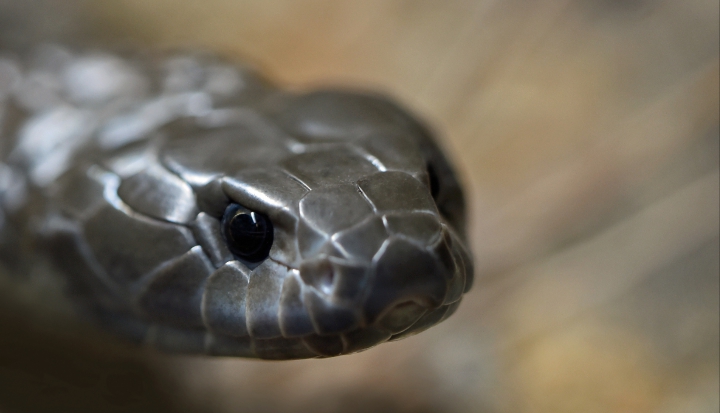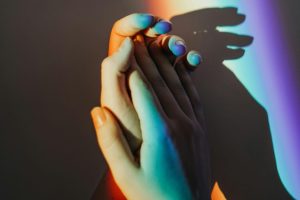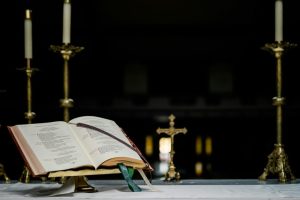Driving on a paved road not far from home last summer, I saw an injured snake, hit by a car, stuck by its open wound to the road. It was curling and writhing, struggling to free itself. I stopped and went back, thinking to move it from the hot, bare road and into the shade and shelter of the weeded ditch where I felt it would eventually die, yet possibly suffer a little less.
As I reached the snake lying on its back, twisted around its wound, and bent to move it, it took one very sharp, deep breath, a gasp so deep I could see its rib cage rise beneath the ivory scales along its upper body, and, in that moment, it died. It lay suddenly without moving, not at all the existence it had been, inexorably altered in being. And its gasp and the dying were simultaneous, the breath stopped, held within the narrow width of its dead body forever.
I was stunned in that moment by an awareness of order and union: the snake at my fingertips had been a living creature, drawing breath as I draw breath, taking air into its body. I had witnessed that breath. Living—the word was suddenly expanded for me in meaning, in impact. It now embodied a compassion of connection wider, more powerful, and more undeniable than any I had perceived before.
One definition of sacred is declared holy. I would declare this moment to be a sacred moment in my life, and I would declare the elements composing this moment—the struggling snake, its life ceasing, the vision of its breathing, the unrelenting summer sun, the steady buzz and burr of the insects in the weeds around us, the fragrance of dry grasses, the boundless blue of the heavens—holy in their bearing of essence and divinity.
A similar moment of enlightenment, also involving a snake, is described in a poem by D. H. Lawrence. On a hot summer day the speaker of the poem comes upon a snake drinking at his water-trough.
He sipped with his straight mouth,
Softly drank through his straight gums, into his slack long body.
Silently . . .
He lifted his head from his drinking as cattle do . . .
And flickered his two-forked tongue from his lips, and mused a moment,
And stooped and drank a little more.
As the speaker watches, he thinks he should kill the snake.
But must I confess how I liked him,
How glad I was he had come like a guest in quiet, to drink at my water-trough
And depart peaceful, pacified, and thankless,
Into the burning bowels of this earth?
The underlying unity of life is revealed in that moment. All life—beautiful or reprehensible, dangerous or benign—takes sustenance from the earth, all lips that drink, all throats and bodies and roots that seek water.
And all forms of life are one in their tenacity, in their determined grip on existence, in their unfaltering will to be, exhibited so obviously in the sow thistle rising through any crevice forced or found in cement or rock; in mayweed and burdock thriving along roadsides, among rubbish and waste; in the unrelenting persistence of birds—sparrows, crows, warblers—up at dawn, even after sudden spring storm of sleet and ice, a long frigid night, calling and scrabbling in the cold, there to survive, crisis or no. “Urge and urge and urge/Always the procreate urge of the world,” Walt Whitman wrote.
This kinship of being, of devotion to life, once recognized, demands respect for each living entity in its place. Another definition of sacred is venerable, worthy of respect.
The living body of faith
My family moved to a farm in Missouri when I was 15. Along with the purchase of the farm, we inherited a herd of sheep, just at lambing season. It was a painfully cold, late January, and when twins were born it was often necessary to bring one lamb into the house to keep it from freezing while the ewe took care of the other. Even today, many years later, I can see those newborn lambs, whiter and cleaner than the snow they lay on at birth, each so immediately out of the warm, wet womb into the wide winter cold, wholly new to their eyes just opened, and, hanging from each lamb, the drying string of a bloody umbilical cord.
I’ve never felt anything again so soft as the fleecy silk of those young lambs, silk so soft it was barely discernible against my fingertips, the sensation enhanced by the feel of the thin, warm body beating beneath. I remember having one of my fingers mistaken for a nipple and taken quickly into a lamb’s mouth, the surprisingly strong sucking and gripping power of that tongue and throat on my finger. Life is this important, this crucial.
We seem to be creatures who need physical sensation, tangible objects to imbue with the abstractions that mean so much to us as a species—innocence, compassion, peace. Each of the newborn lambs we cared for during those years of my adolescence has come to be for me the very feel, the sound, the living body of faith, of purity, and of hope. These are the same virtues many people in the past believed were presented to God in the sacrifice of unblemished lambs. “Behold the Lamb of God,” John the Baptist announces when he sees Christ walking toward him out of the crowd.
The newborn lambs of my adolescence entered the world bearing this history in their being, in their bodies—stories of the sacred. And they were dear to me, their presence enhanced, because of the stories they bore.
The surprise of encountering unusual juxtapositions can also bring awareness of the amazingly divine carnival of life, this sacred circus that surrounds us—the juxtaposition of a tomcat sleeping with a fallen forsythia blossom on his head, a toad found in the toe of a rubber boot, the disappearing and ephemeral form of ocean surf raging against implacable rock, the wild abandon and indifference of nature seen against the static of the man-made, as these lines from the Japanese poet Issa illustrate:
Out from the hollow
of Great Buddha’s nose—comes a swallow.
or the vast and the far seen clearly against the small and the near . . .
A lovely thing to see:
through the paper window’s hold the Galaxy.
Once, in a muddy, ill-smelling chicken yard noisy with cackling hens, I held in my hand one half of a fertilized chicken egg accidentally broken. In the center of that half shell filled with golden yolk, a small dot of bright blood pulsed regularly and steadily into a threaded network of spreading red webs so small and fine they were hardly visible in their reality: heart and its pathways.
For a moment I was lifted out of that scene. The world around me disappeared, and nothing existed in the universe for me except that vibrant red instant of complex life proceeding, though doomed, with astonishing trust. The miracle of it, a hallowed miracle. Who could think otherwise?
“A mouse is miracle enough to stagger sextillion infidels,” Whitman, again. And I agree.
God is in the details
I’ve often experienced a moment of deep happiness when watching someone sleeping, and wondered why. I think what occasions that joy is an awareness of the truth that the body itself is totally innocent, flesh and bone unquestionably fine, justified, and without blame. All aspects—feet and legs, the intricacy of the ears, the grace of the neck and the arms—are sculptures unsurpassed in beauty of line and function. And the hands, solely in and of themselves, are astonishingly perfect and inviolate. Jacob Bronowski writes in The Ascent of Man (Little, Brown, 1976): “I remember as a young father tiptoeing to the cradle of my first daughter when she was four or five days old, and thinking, these marvelous fingers, every joint so perfect, down to the fingernails. I could not have designed that detail in a million years.”
When the human body is sleeping we can see clearly, without interference or confusion, that the body is indeed sacred and honorable—a grand gift we hold in trust. It is sublime and chaste in its loveliness and as unbothered by greed or violence, by deceit or guilt, as a brilliantly yellow cottonwood standing in an autumn field, as the moon filling the boundaries of its white stone place. If there is sin, it resides elsewhere. “The man’s body is sacred and the woman’s body is sacred . . .” wrote Whitman.
The world provides every physical image and sensation we will ever need in order to experience the sacred, to declare the holy. If we could only learn to recognize it, if we could only hone and refine our sense of the divine, just as we learn to see and distinguish with accuracy the ant on the trunk of the poplar, the Pole Star in Ursa Minor, rain coming toward us on the wind; just as we come to identify the sounds we hear, the voices of our children, the creak of the floor at the lover’s footstep, the call of a finch unseen in the top of a pine; just as we can detect and name the scent of cedar or lilac, wild strawberries or river mud and rotting logs.
Might it be possible, if we try, to become so attuned to the divine that we are able to perceive and announce it with such ease too? And perhaps the divine, the sacred, the holy, only come into complete existence through our witness of them, our witness for them and to them. If this is so, then our obligations are mighty and humbling. We are co-creators. We are servants.
I believe we move through the sacred constantly, yet remain oblivious to its presence except during those rare, unexpected moments when we are suddenly shocked and shaken awake, compelled to perceive and acknowledge. During those brief moments we know with bone-centered conviction who it is we are; with breath-and-pulse clarity where it is we have come from; and with earth-solid certainty to what it is we owe all our allegiance, all our heart, all our soul, all our love.
This article was originally published in the March 1998 issue of U.S. Catholic.
Image: David Clode on Unsplash














Add comment